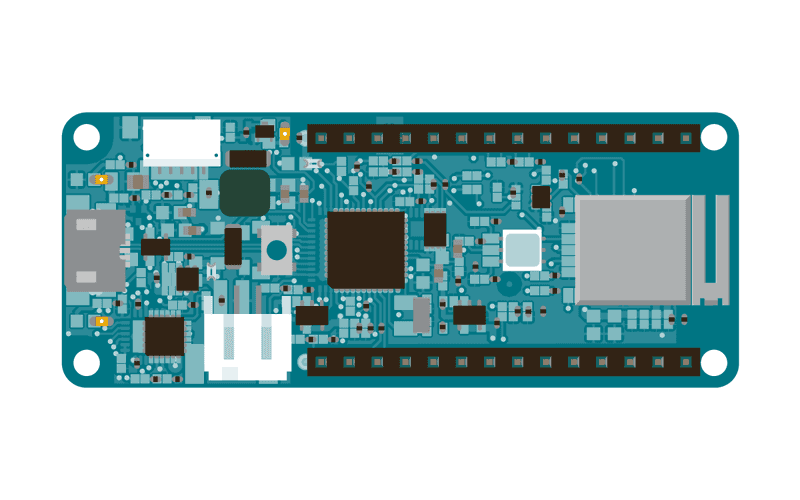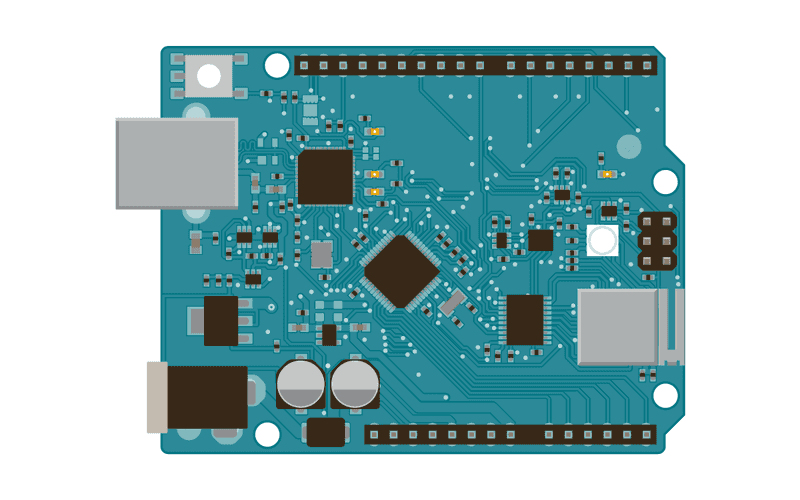WiFi SSL Client
This example creates a client object that connects and transfers data using always SSL.
Hardware Required
Circuit
The WiFi module is integrated on your board and you don't need any special circuitry to get this tutorial to work.
 Arduino MKR WiFi 1010
Arduino MKR WiFi 1010
 Arduino MKR VIDOR 4000
Arduino MKR VIDOR 4000
 Arduino UNO WiFi Rev.2
Arduino UNO WiFi Rev.2
Please note: these three boards use dedicated pins to communicate and select the WiFi module, therefore you have no restriction in the usage of the available digital pins connected to the header pins.
Code
You should have access to a 802.11b/g wireless network that connects to the internet for this example. You will need to change the network settings in the sketch to correspond to your particular networks SSID.
For networks using WPA/WPA2 Personal encryption, you need the SSID and password. The module will not connect to networks using WPA2 Enterprise encryption.
/*
This example creates a client object that connects and transfers
data using always SSL.
It is compatible with the methods normally related to plain
connections, like client.connect(host, port).
Written by Arturo Guadalupi
last revision November 2015
*/
#include <SPI.h>
#include <WiFiNINA.h>
#include "arduino_secrets.h"
///////please enter your sensitive data in the Secret tab/arduino_secrets.h
char ssid[] = SECRET_SSID; // your network SSID (name)
char pass[] = SECRET_PASS; // your network password (use for WPA, or use as key for WEP)
int keyIndex = 0; // your network key Index number (needed only for WEP)
int status = WL_IDLE_STATUS;
// if you don't want to use DNS (and reduce your sketch size)
// use the numeric IP instead of the name for the server:
//IPAddress server(74,125,232,128); // numeric IP for Google (no DNS)
char server[] = "www.google.com"; // name address for Google (using DNS)
// Initialize the Ethernet client library
// with the IP address and port of the server
// that you want to connect to (port 80 is default for HTTP):
WiFiSSLClient client;
void setup() {
//Initialize serial and wait for port to open:
Serial.begin(9600);
while (!Serial) {
; // wait for serial port to connect. Needed for native USB port only
}
// check for the WiFi module:
if (WiFi.status() == WL_NO_MODULE) {
Serial.println("Communication with WiFi module failed!");
// don't continue
while (true);
}
String fv = WiFi.firmwareVersion();
if (fv < WIFI_FIRMWARE_LATEST_VERSION) {
Serial.println("Please upgrade the firmware");
}
// attempt to connect to WiFi network:
while (status != WL_CONNECTED) {
Serial.print("Attempting to connect to SSID: ");
Serial.println(ssid);
// Connect to WPA/WPA2 network. Change this line if using open or WEP network:
status = WiFi.begin(ssid, pass);
// wait 10 seconds for connection:
delay(10000);
}
Serial.println("Connected to wifi");
printWiFiStatus();
Serial.println("\nStarting connection to server...");
// if you get a connection, report back via serial:
if (client.connect(server, 443)) {
Serial.println("connected to server");
// Make a HTTP request:
client.println("GET /search?q=arduino HTTP/1.1");
client.println("Host: www.google.com");
client.println("Connection: close");
client.println();
}
}
void loop() {
// if there are incoming bytes available
// from the server, read them and print them:
while (client.available()) {
char c = client.read();
Serial.write(c);
}
// if the server's disconnected, stop the client:
if (!client.connected()) {
Serial.println();
Serial.println("disconnecting from server.");
client.stop();
// do nothing forevermore:
while (true);
}
}
void printWiFiStatus() {
// print the SSID of the network you're attached to:
Serial.print("SSID: ");
Serial.println(WiFi.SSID());
// print your board's IP address:
IPAddress ip = WiFi.localIP();
Serial.print("IP Address: ");
Serial.println(ip);
// print the received signal strength:
long rssi = WiFi.RSSI();
Serial.print("signal strength (RSSI):");
Serial.print(rssi);
Serial.println(" dBm");
}See Also:
WiFi NINA library - Your reference for the WiFi NINA Library.
Arduino MKR WiFi 1010 - Product details for the Arduino MKR WiFi 1010 board.
Arduino MKR VIDOR 4000 - Product details for the Arduino MKR VIDOR 4000 board.
Arduino UNO WiFi Rev.2 - Product details for the Arduino UNO WiFi Rev.2 board.
AP_SimpleWebServer : A simple web server to manage a LED with AP feature
ConnectNoEncryption : Demonstrates how to connect to an open network
ConnectWithWEP : Demonstrates how to connect to a network that is encrypted with WEP
ConnectWithWPA : Demonstrates how to connect to a network that is encrypted with WPA2 Personal
ScanNetworks : Displays all WiFi networks in range
ScanNetworksAdwanced : Displays all WiFi networks, also the encrypted ones, in range
SimpleWebServerWiFi : A simple web server to manage a LED
WiFiChatServer : Set up a simple chat server
WiFiPing : Demonstrates how to ping a website or IP address
UdpNTPClient : Query a Network Time Protocol (NTP) server using UDP
WiFiUdpSendReceiveString : Send and receive a UDP string
WiFiWebClient : Connect to a remote webserver
WiFiWebClientRepeating : Make repeated HTTP calls to a webserver
WiFiWebServer : Serve a webpage from the WiFi module
Last revision 2018/07/12 by SM